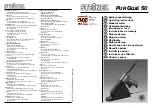
8 GB
General safety rules
Do not use any device if its switch is defective.
A device that can no longer be switched on and
off is dangerous and must be repaired.
Store the device out of the reach of children
when it is not in use. Do not let anyone use the
device if he or she is not familiar with it or has not
read the instructions and advice. Compressed
air units are dangerous when they are used by
inexperienced people.
Maintain the device carefully. Check that mov-
ing device parts are working properly and move
freely. Check for any parts that are broken or
damaged enough to detrimentally affect the
functioning of the device. Have damaged parts
repaired before using the device. Many acci-
dents have their origins in poorly maintained
devices.
Switch the device off if you do not use it anymore.
Always wear personal protective
equipment and safety glasses. Wear-
ing personal protective equipment
such as dust mask, non-slip safety shoes, safety
helmet or ear protectors, depending on the type
of air tool and its application, reduces the risk
of injuries.
Check the connections and supply lines. All
maintenance devices, couplings and hoses must
be equipped to meet the pressure and air amounts
specified in the device specific values. Pressure
that is too low influences the functioning of the
device; pressure that is too high can cause dam-
age to property and personal injury.
Protect hoses from kinks, constrictions, solvents
and sharp edges. Keep hoses away from heat,
oil and rotating parts.
Make sure that the hose clamps are always
tightly fastened. If the hose clamps are not tightly
fastened or are damaged, the air could escape
uncontrollably.
Replace damaged hoses immediately. A damaged
supply line may result in the air hose flapping
about and may result in injuries.
If the power cable of the appliance is damaged,
it has to be replaced by the manufacturer or its
service department or a similarly qualified per-
son in order to avoid hazards.
Do not use the device when tired or under the
influence of drugs, alcohol or medications. One
moment of carelessness when using the device
may result in serious injuries.
Do not directly inhale the exhaust air. Keep eyes
away from exhaust air. Exhaust air from the air
tool may contain water, oil, metal particles or
contaminants from inside the compressor. This
may damage your health.
CAREFUL WHEN PUT-
TING THE TOOL DOWN!
Always put down
the device so it does not come into contact with
the trigger. This could potentially result in acci-
dental activation of the device, which again
could result in hazards.
Only use suitable accessories. These may be
purchased from the manufacturer. Using non-
OEM accessories may result in hazards.
Only use filtered and regulated compressed air.
Dust, caustic vapours and / or moisture may
damage the motor of the compressed air tool.
The hose must be designed for pres-
sures of at least 6.3 bar or 125 PSI,
but at least 150 % of the maximum
pressure generated in the system.
The tool and supply line must be
equipped with a hose coupling to
completely release pressure when
disconnecting the coupling hose.
DANGER!
Avoid contact with live lines. This
device is not insulated against electric shock.
RISK OF INJURY!
High
working pressures can give rise to recoil forces
that under certain conditions can result in danger
from continuous loading.
If you are inexperienced in the use of this type
of device, you should seek training on how to
handle it safely.
DANGER OF STAB
WOUNDS!
Do not treat an injection as a simple
cut. A high pressure jet may inject toxins into
the body and cause serious injuries. If the spray
is injected into the skin, seek medical help im-
mediately.
Do not modify this device in any way without the
manufacturer‘s approval.
Only use the compressed air unit with the spec-
ified pressure (6.3 bar).
Disconnect the compressed air unit from the air
supply after each use and when not in use.
General safety rules





































